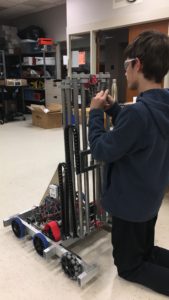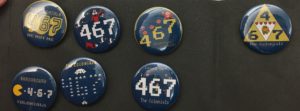Hello everyone!
Yesterday marked two weeks left of our team’s build season. The past four weeks have been very productive and busy as we work toward the completion of our robot. With very little time left, the pressure is greater than ever as we race to build our robot.
This year, our robot’s design is built around the elevator that will allow the robot to complete challenges. The elevator actually isn’t quite a elevator, but it is a elevator-type mechanism. If you first saw it, the likely first comparison you’d draw is to a forklift. The design is, essentially, a forklift with a grabber on the end. The grabber will allow our team to grab the cubes and transport them wherever on the field we need to bring them.
Pictured here is one of our members, Jack Doyle, working on the robot. As you can see, the robot has six wheels and a elevator mechanism. Although it can’t be seen in this image, the elevator is capable of extending to over nine feet. The robot is nearing completion but with every season comes new challenges. If there’s one thing we’ve learned, it’s that there’s bound to be errors near the end of the build season. Build season is a time where every minute matters. The construction of the robot is often done down to the very last available minute. With such a complex operation, there is so much that can go wrong. Whether it is a programming error or a part malfunctioning, anything can happen. Knowing that something is always going to happen, we have to be ready to combat the issue as swiftly and as efficiently as possible.
One of our members, Stephanie Huang, explains this concept quite well. “It feels very productive when you know everything and you can contribute to the functions of the robot. But when you run into an error, it is beyond frustrating.” When this happens, she explains that there is one process the team makes use of that has been put to use time and time again. They must change the programming of the robot and try again. If, after running the new programming, the error is still showing up, they repeat the process. She said that it is “very tiresome but necessary”.
When I asked her for other things she thought readers should know about our team, she explained about the team’s work ethic and personality. It is a team that works hard but she says that the “work is relaxing”. The team makes sure that everyone has some sort of freedom with what they are working on. They aren’t forced into working on a part of the robot. On the contrary, they get to choose what to work on and actually enjoy their work.
Next, I talked with Zoie Leo who works on the drive train. She explained that the first chassis and drive train have been completed for the test robot. The test robot is the first robot the team builds and isn’t sent to the competitions. After the completion of the test robot, the team starts working on the competition robot. This robot is the one that will be sent to compete in competitions. When the competition robot is bagged at midnight on the final day of the build season, the test robot is used to work out errors and make adjustments to the programming. As of now, the team is starting work on the second chassis for the competition robot. Zoie explained that this year our team is using a “West Coast-style drive train with omni wheels in the front to help with turning [the robot] quicker”.
In addition, some of our team members have been working on designs for pins that we will be distributing at competitions. Here are some examples:
As the team starts work on the second robot and the days tick by, the pressure will only increase. However, with nearly twenty years of experience under the team’s belt, we are more than confident the robot will be complete two weeks from now and ready for competition.


